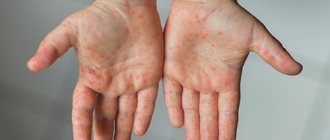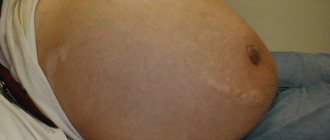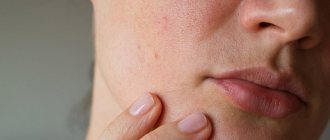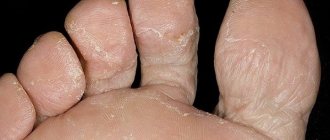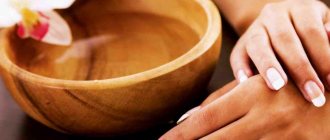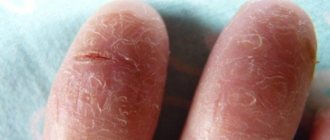The skin on the hands is most susceptible to external influences. Brushes come into contact with aggressive components and are less protected from frost and sun. The reaction may include small, watery pimples that appear on the palms, fingers, and outside of the hands.
The blisters can be very small, often spaced, similar to bumpy skin or larger and appear at a distance of 3-4 cm from each other. Since the hands are always visible, such rashes cause psychological discomfort in a person. In most cases, water pimples are very itchy. Let's consider what it could be.
Symptoms and manifestations
Blisters are round or oval bumps of fluid under the skin that may be painful and itchy, or cause no symptoms. Symptoms vary depending on the cause:
- Irritation, Burns and Allergies – Blisters caused by friction or burns are usually painful. Blisters on the hands that occur with eczema are itchy and may be accompanied by redness and severe itching.
- Infections. When blisters cause infections, symptoms vary depending on the type.
- Bullous impetigo. When exposed to skin, the blisters may turn red.
- Herpes virus. Type 1 causes small blisters, and there is an increased temperature in the affected areas of the skin with herpes. The skin may itch, tingle, swell, and become red until blisters appear. When the blisters eventually rupture, fluid leaks out and painful sores form.
- Varicella-zoster virus – When this virus causes chickenpox, the skin becomes inflamed and develops an itchy rash that quickly turns into blisters.
- Coxsackie A16 can cause illness in the hands, feet and mouth, often causing painful blisters on the hands, feet and mouth.
- Skin diseases - erythema multiforme usually causes blisters on the palms, forearms, feet and mucous membranes of the eyes, nose, mouth and genitals. Other symptoms include fever, sore throat, cough and muscle pain. A patient with dermatitis experiences itching, red nodules, or blisters. Pemphigoid is a rare disease that mainly affects older people and causes large blisters, itching and burning.
- Drugs. Reactions to medications vary. In some cases, there is only increased sensitivity to the sun, which can lead to the formation of blisters on the skin in the form of burns. In more severe reactions, blisters can cover large areas of tissue, including the respiratory tract and gastrointestinal tract, which is accompanied by an increase in body temperature and poor health (general malaise).
Allergic reaction
Allergies in the form of small drops of water covering the fingers, accompanied by severe itching, are caused by various allergens.
Allergies may occur:
- As a reaction to some food product;
- As a reaction to any household chemicals (detergents, cleaning products, washing powder);
- In case of cold wind or frost,
- When exposed to the sun for a long time,
- How to react to medications;
- For herpes;
- For herpes zoster;
- For autoimmune diseases;
- Ordinary pemphigus.
The main principle is to rid the body of the allergen that causes severe skin irritation and itching.
If small blisters itch, then use corticosteroids in the form of ointments, gels, aerosols (dexpanthenol, fenistil) and antihistamines (citrine, suprastin, diazolin), enterosorbents (activated carbon, white carbon, enterosgel).
Coping at home
Non-medicinal products include available substances that can be purchased at home. You can use panthenol-based cream, which is good for burns.
Burgundy skin is immediately lubricated with sour cream, kefir or ointment after sunbathing. The procedure is repeated every half hour, waiting for complete absorption.
It is better to open large blisters in the surgeon's office. He will immediately apply a bandage with a medicinal agent, which will have to be rewound daily. The released bacterial environment can infect others; antiseptic treatment is required before applying the medicine and after opening the compress. Levomekol or Syntomycin will help reduce the development of inflammation.
In case of fungal infection of the feet, treat the skin with camphor or alcohol solutions. Pruritic disorders are relieved by Fenistil gel and other painkillers. If chemicals come into contact with human tissue, you cannot use a specific type of drug.
It is better to select a remedy together with a dermatologist.
What herbs should I take for dropsy of the hands and feet?
Herbs for dropsy are also taken orally. RECIPE 1 : Cowberry leaf decoction. Take:
- 2 teaspoons lingonberry leaves
- 250 ml water
- The leaves are boiled in boiling water for a quarter of an hour.
- After 30-40 minutes, the cooled broth is drained through a sieve.
- Drink 3 tbsp decoction. spoons throughout the day.
Lingonberry leaf decoction.
RECIPE 2 : Wild elderberry tincture (root). Take:
- 0.5 tsp wild elderberry root powder
- 200 ml water
- The powder is poured into a glass of boiling water.
- The product is infused overnight and filtered.
- An infusion of wild elderberry root is drunk in two doses.
Wild elderberry infusion.
RECIPE 3 : Parsley decoction in milk.
Take:
- 800 g parsley herbs
- 1 liter of milk
- Washed and chopped parsley is added to boiled milk.
- Simmer the broth over low heat until half the volume of milk has evaporated.
- Strain the broth.
- Drink 1-2 tbsp. spoons of decoction every hour.
Parsley in milk.
Treatment of rashes
In the case where redness appears on the skin and blisters under the skin, measures must be taken to eliminate the negative symptom as quickly as possible. TO
A specialist (dermatologist or allergist) can tell you how to get rid of the problem, how to more effectively treat the rashes that appear on your hands or other parts of the body, based on the results of studies and diagnostic procedures.
So, if the main disease that caused the formation of blisters is urticaria, then taking antihistamines (tablets or ointments) is required.
Medicines such as Diazolin or Erius, Dixamethasone, as well as activated carbon or Smecta are used to remove harmful components from the body.
If the skin problem is caused by fungal infections, then agents with an antifungal effect are used for treatment. The drugs include drugs such as Octathion, sulfur-tar ointment or Mycozolon.
The start of treatment cannot be delayed, since in the event of an allergic reaction to an irritant, delay can cause serious complications, including anaphylactic shock or Quincke's edema. In this case, treatment must be carried out immediately and professionally, since health complications, increased negative reactions, and even death are possible.
It is important to remember that rashes cannot be ignored, even if the blisters appear for other reasons. This is due to the fact that the development of all pathologies without exception is the cause of disruption of most functions of other organs or their systems
Self-treatment is possible only under the strict supervision of a doctor.
This is due to the fact that the development of all pathologies without exception is the cause of disruption of most functions of other organs or their systems. Self-treatment is possible only under the strict supervision of a doctor.
It will help you choose folk remedies for subsequent prevention, since you can get enough useful substances from herbs and plants to restore and strengthen the body weakened by the disease.
Thus, rashes in the form of blisters on the phalanges or between the fingers, on the palms or in the area of the elbows may indicate the development of complex diseases.
A variety of factors can cause skin disorders, ranging from allergic reactions to complex fungal or infectious diseases.
Itchy
- All day.
- Sometimes it appears regularly or at a certain point in the day.
- Often appears at night, as if under the skin.
At the same time, you need to remember that scratching them is prohibited; a damaged vesicle, and as a result, the skin, will cause the development of inflammatory processes caused by infection. This leads to serious diseases of the skin and joints. It is dangerous if cracks begin to appear.
Traditional medicine recommends using cold compresses using medicinal herbs and baking soda. Be sure to visit a specialist.
Watery blisters on hands: how to identify the cause...
Treatment of blisters on the hands begins with identifying the provocateur of their appearance. A pathogenetic approach to eliminating the problem will ensure not only a complete victory over its manifestations, but also the prevention of repeated encounters with trouble. If you treat only a symptom, its original source can “lurk” and continue to destroy the body covertly, periodically causing systemic failures in its functioning.
Caution: infection
Inflamed itchy blisters and purulent pimples on the hands can be the result of an infectious skin lesion. Bubbles with liquid content accompany the development of the following infectious diseases:
- scabies;
- chicken pox;
- rubella;
- smallpox
A common cause of rashes on the hands is scabies. It is easy to distinguish it from other “relatives”:
- starts with the hands - the first bubbles appear between the fingers;
- severe itching - especially at night and after contact with water;
- the bubbles merge with each other - and grayish channels become noticeable under the skin.
The remaining infectious rash provocateurs manifest themselves starting from the face, abdomen, armpits, and only after that the water rash spreads to the hands and forearms.
Often the cause of a rash on the back of the hands and palms is a fungal infection. It has its own distinctive features:
- dense structure of bubbles;
- peeling and dry skin;
- cracks;
- unpleasant odor;
- itching of the skin without obvious changes.
People who neglect to wash their hands and come into contact with dirt without using gloves may also experience pimples (pimples) on their hands and fingers. Staphylococcus aureus and streptococcus can provoke rashes. Penetration of infection into the sebaceous and sweat ducts is usually accompanied by the appearance of single white purulent pimples on the hands.
Elimination of infectious causes requires accurate identification of the pathogen. It is determined using analysis. Only a specialist can prescribe a study and correctly evaluate its results.
Allergic reaction
Small blisters on your hands may indicate an allergic reaction. They accompany such a phenomenon as urticaria - the skin on the hands turns red and rises. At the borders of hyperemic spots, small bubbles with liquid contents appear. Such symptoms can also appear in a child. Small pimples can also appear on the legs. They look like dropsy and cause irritation.
Allergy on the hands is of contact origin - it is provoked by a specific substance with which the skin of the hands came into contact some time ago. The most common causes of urticaria on the hands are:
- detergents;
- cosmetic products;
- household dust;
- animal hair;
- alcohol;
- low temperatures (frost allergy);
- ultraviolet.
Redness of individual areas on the hands can also be caused by a systemic allergic reaction, but this situation is observed much less frequently. As a rule, systemic allergies are accompanied by additional rashes on the face and chest.
Ignoring hand allergies leads to blisters bursting, forming multiple ulcers and erosions. The subsequent development of the pathology is fraught with transformation into an eczematous lesion, the treatment of which is difficult even for modern medicine.
Palmar hyperhidrosis
Multiple clear blisters on the hands may indicate palmar hyperhidrosis. This is an increased activity of the sweat glands, which causes rashes, popularly called prickly heat. This phenomenon is accompanied by wet palms syndrome, which causes moral discomfort in the patient.
There are extremely few sebaceous glands on the palms and back of the hands. This is the reason for the skin's tendency to become extremely dry. However, even a minimal number of sebaceous ducts can provoke the appearance of dry, hard nodules on the surface of the skin. They are often mistaken for subcutaneous pimples and attempts are made to squeeze them out. In fact, the problem is the accumulation of skin secretions in the sebaceous gland capsule.
Systemic disorders
The appearance of pimples and blisters on the body may be associated with disturbances in the functioning of the organoleptic systems. Hands are no exception. The rash appears on them as a result of:
- hormonal imbalances;
- stressful situations;
- nervous disorders;
- intoxication of the body;
- metabolic disorders;
- improper nutrition.
The doctor can accurately determine the cause by prescribing the patient the appropriate tests and collecting a high-quality medical history. It is extremely difficult to independently determine one of these reasons.
Dropsy - what kind of disease is it?
IMPORTANT: “Dropsy” is the popular name for several diseases at once. This word refers to a water callus - a bubble on the skin, most often formed as a result of friction, as well as the accumulation of water or serum fluid in the subcutaneous tissue in a particular area or a certain cavity of the human body. If a callus is just a nuisance, knowing how to remove it is quite easy, then dropsy-edema requires complex treatment, its causes lie in health problems.
Dropsy - subcutaneous swelling occurs:
- general - excess fluid is distributed under the skin of the entire body at the same time
- local – swelling is observed under the skin of a specific area of the body
The fluid leaving the blood and lymph vessels is called transudate. Dropsy is most often diagnosed:
Abdominal, or ascites. In this case, transudate (excess fluid) accumulates in the abdominal cavity due to poor circulation in large arteries. Sometimes such swelling signals heart failure. Its treatment is aimed, first of all, at eliminating the disease - the cause, and is carried out exclusively by doctors. Surgery may be required.
Ascites.
Head, or hydrocephalus. Cerebrospinal fluid accumulates in the cranial cavity, most often in the ventricles of the brain. The causes of hydrocephalus are injuries and internal diseases that lead to various types of brain damage, due to which there is a violation of blood circulation in the cerebral vessels. Hydrocele of the brain is treated conservatively and surgically. They eliminate both the cause of fluid accumulation in the skull and its consequences.
Hydrocephalus.
Pericarditis, or hydropericarditis. Impaired blood flow or vascular permeability, leading to the accumulation of transudate in the pericardial sac, is provoked by diseases of the kidneys, liver, parasitic and infectious diseases, as well as blood cancer. It is treated conservatively, but in some cases a pericardial puncture is performed to pump out fluid.
Hydropericarditis.
Testicular, or hydrocele. Fluid accumulates between the layers of the vaginal process of the testicle. It is more often observed in infants and is associated with characteristics of embryonic development. But it can also be the result of an inflammatory process. It is treated surgically.
Hydrocele.
Uterus and fallopian tubes, or hydrosalpinx. Most often, fluid immediately accumulates in the left, right, or both fallopian tubes as a result of dormant or untreated inflammation of the female reproductive system. Tubal obstruction caused by dropsy is often treated surgically.
First aid
A rash on the hands can be a manifestation of many diseases. There is no need to try to diagnose yourself; it is best to talk about the problem with a dermatologist.
But often severe, persistent itching begins in the evening or at night, and no increase in temperature, shortness of breath, or other life-threatening symptoms are observed, so it is awkward to call emergency medical care. Are itchy blisters on your hands bothering you? Both medications and folk remedies can help relieve irritation. So, treatment for blisters on the hands:
Carefully, trying not to damage the inflamed area, treat the skin with an antiseptic. Any cooling anti-inflammatory ointment will alleviate the condition. It must be carefully and evenly applied to the affected areas of the skin. You can put gauze folded in several layers and soaked in cold water on your hands.
This compress needs to be changed every 10 - 15 minutes. A soda solution (1 tbsp of warm boiled water - 2 tbsp of soda) is carefully applied to the areas of inflammation, washing them. The product can help with multiple mosquito or midge bites, relieving severe itching.
Baths from a decoction of chamomile, string, celandine (if the rash is not caused by an allergy to herbs) are done every 1 - 2 hours, if the itching does not give rest, until the symptom disappears. A rich nourishing cream is applied to hands affected by dermatitis after contact with ice water, cold air, and sunburn. It would be wise to take any antihistamine to avoid triggering a more serious allergy attack.
A visit to the doctor should not be postponed, as the rash may be a manifestation of chickenpox, measles, scabies, syphilis, scarlet fever and other dangerous diseases. Even if the rash goes away after a few hours, you need to find out what caused it.
Mild irritation after contact with a new detergent or any other substance can lead to eczema, a very unpleasant and difficult to control disease.
If irritation occurs
Itchy water blisters on the pads and fingers require first aid - taking an antihistamine (diazolin, cetirizine), which relieves internal tension and discomfort. As first aid, use a cold compress using camphor, menthol or tea tree oil.
For scabies, birch tar, which is applied to the affected areas of the skin, relieves itching. Scabies mite in the photo:
To prevent a rash and relieve itching, it is important:
- Avoiding stress;
- Following a diet excluding foods that cause allergies;
- Maintaining hygiene;
- Work with household chemicals only with rubber gloves, replace the product with a less aggressive one;
- Drink plenty of water;
- Taking vitamins A, B, E.
↑
How to treat?
This problem is treated exclusively under the supervision of a doctor, who completely selects a set of necessary procedures for the patient. Depending on the intensity of the appearance of blisters under the skin on the hands, as well as the degree of neglect, the therapy will differ.
What procedures can help eliminate small subcutaneous blisters on the palms of the hands?
- First, it is necessary to completely eliminate the causes of formation. If it's all about nervous tension and stress, then you need to take a course of sedatives. In addition, you should spend more time sleeping, taking baths with aromatic oils and taking walks in the fresh air.
- If the problem appears due to an allergic reaction, then you should exclude any contact of allergens with the skin of your hands. Completely avoid unsafe household chemicals and try to use modern products that do not contain chlorine, phosphates, aggressive surfactants and dyes.
- Reflexology and acupuncture can help relieve nervous tension. And rashes can be cured with cryptotherapy (cold).
- A course of antihistamines will help relieve reactions to allergens and relieve itching.
- A strict salt-free diet will help normalize metabolism, as well as speed up the restoration of damaged tissues and the body as a whole. Try to give up everything salty in favor of fresh vegetables and fruits.
- During treatment, you should avoid skin care treatments. The use of various oils and creams can cause even more irritation on the skin.
- Lotions with infusions of medicinal herbs will also help cope with the problem. You can apply compresses with infusions of oak bark, chamomile, sage and celandine. The doctor may also prescribe you a mash to apply to the affected areas of the skin.
Dropsy on the legs and arms in the elderly, adults and children: symptoms
If dropsy of the limb appeared only once and went away on its own, most likely it was a physiological reaction. If the arms and legs swell systematically, the swelling gets worse, we are definitely talking about pathology, and you should definitely consult a doctor. Here are the symptoms of dropsy that should alert you:
- Both or one of the limbs swells locally at once.
- The swollen area feels like dough to the touch.
- The skin on the swollen area is glossy, stretched, pale and loose, and bluish. If trophic skin changes appear on it, this indicates a severe degree of edema.
- When you press on the swollen area, a dimple-dent remains on it.
A pit on the skin on palpation of dropsy.
Methods for treating watery blisters
Treatment for a rash usually begins with addressing the underlying cause. Therapy includes a combination of medications and home remedies, depending on the patient's condition.
Medications
Watery blisters on the skin accompanied by other symptoms, such as inflammation or infection, require medications to reduce inflammation and eliminate bacteria.
These may include oral antibiotics to prevent the effects of the vesicles from getting worse. For eczema, retinoids and glucocorticoids are prescribed. Blisters caused by burns are treated with prescription creams and ointments. Oral antibiotics are prescribed to reduce the chance of infection. Antihistamines are designed to eliminate blisters caused by allergies.
Drugs that help in treatment:
| Type of disease | Drugs | Well | Price in rub. |
| Herpes rashes | Zovirax | From 4 to 10 days, treatment 2 times a day, | 150 |
| Acyclovir | ointment treatment up to 5 times a day | 112 | |
| Scabies | Spray "Spregal" | Apply to the skin in the evening for 8-10 days | 800 |
| Emulsion "Benzyl benzoate" | Rub in for 10 minutes for 2 days. | 18 | |
| Vesicles caused by fungi | Lamisil | Apply once a day for 1 week | 450 |
| Zalain | 2 times a day until the bubbles disappear | 400 | |
| Vesicles caused by eczema | Hydrocortisone ointment, | Apply a thin layer no more than 4 times a day | 25 |
| Castellani liquid or Fukortsin | Moisten with a tampon 4 times a day | 23 | |
| ointments with ketoconazole, | 1 time per day for 7 days | 100–200 | |
| Triderm | Duration of treatment is individual | 600 | |
| Burn blisters | Belanten ointment | Apply 1–2 times a day | 400 |
| Allergy blisters | Claritin | 1 tablet per day | 200 |
| Erius | 5 mg per day | 300 | |
| Smecta | 2 sachets per day | 130 | |
| Hydrocortisone | Apply a thin layer no more than 2 times a day | 26 |
In case of problematic skin, heavy sweating, which causes the appearance of watery formations, antiseptic astringents should be used. If the area of coverage is insignificant and they do not bother you, then in this case it is not recommended to touch them and lubricate them with various creams and lotions.
As the skin underneath the blisters regenerates, the fluid will disappear and the skin will dry out. It is best to keep the blisters intact to prevent infections.
Traditional methods
Watery accumulations that are not based on infectious lesions can be treated with natural materials or creams based on them:
- Aloe vera. Ointments, creams, lotions have anti-inflammatory properties and promote rapid healing
- Apple vinegar. Antibacterial properties help reduce swelling and dry out the blister.
- Tea tree oil. The antibacterial and astringent properties of the oil help quickly get rid of bubbles.
- Camomile tea. Wet compresses help in recovery from skin diseases.
- Decoction of marigold flowers. Compresses heal affected areas of the skin well.
- Witch hazel cream.
Other methods
Watery blisters on the skin can be treated independently using anti-inflammatory and cooling agents:
- Levomekol. Antibacterial agent, used for prevention when combing and rubbing blisters. Price 100 rub.
- Neosporin. Ointment, soothing, analgesic, price 400 rubles.
- Panthenol. Do not lubricate wet wounds. Price 100 rub.
Vitamins of group P, PP, B, C help, which improve skin condition:
- Niacin;
- Aevit;
- Complivit.
Home therapy
Let's look at the most effective folk recipes:
- Aloe. You need to use aloe leaves, releasing their juice, they help well with the problem. The leaves should be applied to problem areas so that they do not interfere with your body movements; it is better to wrap them with a bandage.
- Comfrey officinalis. The leaves of this plant are used for poultices; to do this, pour boiling water over the chopped leaves for 15 minutes. Then put the steamed leaves in gauze and apply to the problem area; this should be done several times a day, for a maximum of 30 minutes.
- Calendula ointment. It is good for healing damaged vesicular blisters. It should be applied in a thin layer and covered with gauze.
Causes
Skin rashes in the form of blisters with liquid appear in adults as a reaction to the influence of negative factors from within the body or from the external environment. The cause may be rubbing with clothing, kitchen utensils, garden tools, thermal and chemical burns. But the most serious group is disorders of the functioning of organs and systems of an immune, metabolic, and nervous nature. Internal imbalance becomes the background for diseases of various etiologies.
Contact dermatitis
Skin irritation occurs due to contact with certain substances, for example:
- household chemicals, especially alkaline,
- hygiene, cosmetic products,
- medications,
- metals,
- synthetics,
- plants,
- animals, insects.
Allergic dermatitis
A malfunction of the immune system leads to the fact that the body perceives foods, drinks, and medications that are generally harmless as dangerous to health. As a result, a reaction of rejection occurs - inflammation of the skin, profuse dry and watery rashes like urticaria on the face, hands, folds, and legs.
Toxicoderma
Individual intolerance in the form of a reactive rash and eczema can manifest itself to any group of medications, 120 types of food allergens, and metals in production (nickel, cobalt, chromium). Symptoms of toxicoderma disappear in the absence of the action of the irritant and quickly return when the slightest dose enters the body.
Bacterial infection
Bacteria such as streptococci and staphylococci provoke diseases with vesicular and pustular rashes:
- pyoderma - purulent inflammation of the epidermis,
- vulgar mixed impetigo - a rash of phlyctenas (bubbles) with purulent filling and rough crusts hiding erosions,
- ecthyma is an inflammatory-purulent process in which conflicts deepen erosion over the entire thickness of the skin.
Viral infection
Scatterings of small blisters often turn out to be a manifestation of herpes infections - chickenpox, shingles. Herpes virions are usually transmitted by airborne droplets.
Chickenpox, which is easily experienced by children, causes a lot of suffering in adulthood. The pink spots that appear at the first stage are covered with itchy and painful vesicles. The blisters burst, revealing wet ulcers. Before the wounds have time to become covered with crusts, more and more lesions appear. Chickenpox brings high fever, chills, loss of appetite and sleep. Scratching can introduce purulent bacteria into the wounds.
Herpes zoster is especially difficult. Thick blistering rashes in bands are located along the line of nerve fibers affected by herpes virions. Severe neuralgic pain haunts the patient not only in the acute phase of pathogenesis, but also many months later.
Fungal infection
Various fungi constantly parasitize human skin. Their pathogenic activity is restrained by the immune system. Depletion of protective resources and skin injuries create favorable conditions for the activation of mycotic diseases. The trichophyton fungus causes small blisters between the toes of very sweaty feet, which quickly grow into bullae.
Diseases of the nervous and endocrine system
Depression and stress, thyroid dysfunction, diabetes mellitus disrupt the passage of electrical impulses, metabolism and hormonal control of all processes in the body. All this negatively affects the condition of the protective skin barrier. The epidermis changes its physical and chemical structure, resulting in various types of water blisters.
Autoimmune pathologies
Diseases that arise due to the aggression of protective bodies against protein compounds of the body are called autoimmune.
- In old age they suffer from chronic bullous pemphigoid. The skin on the arms, legs, and stomach is covered with blisters that are filled to the limit. The foci of their accumulation are located symmetrically.
- A recurrent disease, dermatitis herpetiformis, causes high fever, disrupts intestinal functions, and leads to depression. A polymorphic rash (various in contours and size) appears on the knees, elbows, from the back of the head to the buttocks. The unbearable itching is accompanied by a feeling of burning, tingling, and crawling. Dühring's dermatitis may indicate a malignant tumor within the body.
- Pemphigus is less common, but is more severe. Its multiforme vesicles sprinkle the body, quickly merging into extensive foci.
Who can help?
The skin of the hands is one of the first to react to problems in the body, which is why there are dermatologists in almost all clinics and regular clinics.
See a doctor immediately if:
- the rash appeared against a background of high temperature, swelling spreads throughout the body and very quickly (we can talk about the lightning development of a dangerous and contagious infection or an allergic reaction that affects the activity of vital organs);
- the blisters are very large, burst, and in their place weeping ulcers appear;
- along with itching, difficulty breathing and confusion are observed; dizziness, intestinal upset;
- if a rash of blisters appears on the hands of a small child who is unable to tell what he ate or drank, what he touched, what hurts at the moment;
- blisters on the hands do not go away for a long time, or the rash appears more and more often.
A full examination can be done in clinical diagnostic centers, where the causes of symptoms are identified and a detailed blood test is done to identify viral or bacterial infections, parasitic infections, sexually transmitted diseases, oncology, and allergies.
You should not rely on help in cosmetology clinics in case of exacerbation of diseases; here they can only help eliminate the traces left after treatment.
When a rash appears, the first specialist to contact is a dermatologist. After examination and collection of biological material for analysis, the doctor will make a preliminary diagnosis and prescribe the necessary treatment.
If doctors suspect the presence of a serious or chronic disease, they will prescribe additional tests and refer you to an allergist, infectious disease specialist, parasitologist, neurologist, nutritionist, and other specialists. Sometimes you need to visit a therapist if the rash is a symptom of one of the diseases of the internal organs.
Provoking diseases
A skin rash often signals problems with internal organs, and it should not appear in a place close to the organ.
A rash on the hands often indicates liver problems.
Bubbles can appear as a result of problems with the digestive system, hormonal problems, various poisonings, be it food or drug poisoning.
The most common cause associated with pathology of internal organs is cirrhosis of the liver. Therefore, at the first manifestations of a rash, you need to consult a doctor to begin treatment.
Treatment
Let's look at the main problems:
- For nervous tension, take sedatives and antihistamines (diphenhydramine). Doctors advise avoiding stress, having healthy sleep, walking in the fresh air, and a balanced diet.
- Fungal infection (mycosis) should not be confused with eczema; the disease cannot be determined visually (the diagnosis can only be made using laboratory tests). The peculiarity of the fungus is dry and cracked skin, small blisters with liquid appear between the fingers and then transfer to the nail plates. They are treated comprehensively with external antifungal ointments or gels (mycosan, clotrimazole, bifonazole) and antifungal drugs for internal use.
- For infectious diseases (measles, chicken pox, urticaria), it is necessary to consume a sufficient amount of foods containing vitamin C (vegetables and fruits) and calcium (milk), hygiene, and drinking plenty of fluids. Therapy is usually aimed at preventing complications.
- Scabies, or infestation with scabies mites, is an acute infectious disease in which infection occurs as a result of bodily contact with a sick person, his clothes, or bedding. Treatment is carried out externally using medications (talkers) based on sulfur and lindane. Clothing, bedding, all things with which the patient has been in contact must be treated thermally (boil thoroughly); the patient must comply with all hygiene requirements, especially those related to the daily change of clothes and bed linen.
- For dyshidrosis, or dyshidrotic eczema (prickly heat), it is advised to wash your hands frequently, wipe them with ethyl alcohol, and then apply a corticosteroid (hydrocortisone, lorindene) and an antihistamine (bipanten, elocom, advantan). Use as recommended by a doctor.
- If you have allergies to your fingers, you should not get them wet. Antihistamines are taken internally (citrine, tavegil, fenistil, diazolin)
It must be remembered: whenever this problem occurs, only a doctor can prescribe a course of treatment. Self-medication is dangerous for the patient and for others.
Preventive measures
To prevent watery pimples from appearing on your fingers, you need to maintain hygiene and strengthen your immune system, because the likelihood of damage is higher in a weakened body.
- Wash your hands frequently, inspect them for cuts, hangnails, and splinters to prevent infection from entering the damaged epidermis.
- Take vitamins, especially in the off-season. Lemons, cauliflower and white cabbage help saturate the body with vitamin C.
- Eat vegetables, fruits, drink juices for additional nutrients and improve the functioning of the digestive system.
- Ensure yourself a healthy sleep. If you suffer from insomnia, you need to walk vigorously in the evenings, drink a glass of milk with a teaspoon of honey at night.
- To strengthen the immune system, take ginseng tincture, echinacea, Anaferon.
If a rash appears on your fingers (palms, elbows and other areas), you should definitely consult a doctor and undergo an examination. The doctor will help you find out what caused this symptom. The rapid disappearance of acne does not always indicate complete recovery. In some cases, the disease may become latent.
Help from herbalists
Traditional medicine recipes are successfully used in the treatment of many diseases. Rashes on the skin of the hands are no exception. However, despite their effectiveness, they should not be used without a doctor’s recommendation. Moreover, they cannot be used if the following symptoms are observed:
- The blisters began to crack;
- They secrete fluid or pus;
- The number of formations is increasing all the time;
- Symptoms of inflammation are visible at the site of bubble formation.
If these signs are absent, you can choose one of the recipes we offer.
Fungal infection.
Brew strong coffee from freshly ground beans. Cool slightly and make hand baths in it for 15 minutes. Treat formations with tea tree oil. This remedy is good for both treatment and prevention of the disease.
Prickly heat.
Oak bark tincture has an excellent antiseptic and drying effect.
Scabies.
To prepare an oil solution based on garlic, mustard oil is used. Pour 100 g of chopped garlic into 1 liter of vegetable oil and cook for 20 minutes. After preparing the solution, the remaining garlic is squeezed out and the oil is used to rub the skin.
Lavender oil, which is rubbed into damaged areas of the skin, also helps relieve itching and inflammation due to scabies.
Allergy to cold.
Prepare a tincture of yarrow (at the rate of 1 glass of water per tablespoon of herb) and use 3 times a day before meals.
Food allergies.
The infusion of the series is taken for a month, 3 times a day, 0.5 cups. There is no need to cook this product. It is enough to pour 4 tablespoons of the string with a liter of boiling water and leave overnight.
Herbs that have anti-inflammatory and wound-healing effects have proven themselves well:
- Chamomile;
- Celandine;
- Plantain;
- Calendula.
Treatment
Sometimes the inflamed skin on the fingers itches so much that you want to “tear” the skin. The danger of the disease is that scratching the blisters between the fingers leads to the spread of the disease, an increase in the area of skin damage and itching begins even more.
Moreover, bacteria can get into open wounds and associated diseases can occur. Therefore, at the first signs of occurrence, you should urgently go to the doctor.
If the skin itches severely, first aid can be carried out using a regular cabbage leaf (it cools and soothes the skin well) or aloe juice diluted with water (1:1), they need to lubricate the inflamed areas 2 times a day.
Lotions or baths made from infusions of chamomile, mulberry, and oatmeal relieve swelling and relieve itching well.
Water pimples as a result of external influences
Watery blisters on various parts of a child's skin may appear as a result of a burn. A distinctive feature of such formations is that they appear in places of direct contact with the irritant. The area of damage and severity depend on the type of burn.
Burns are divided into the following types:
- Sunny. They appear after prolonged exposure to the sun on uncovered areas of the skin. The bubbles burst a few days after they appear. May be accompanied by fever and itching.
- Thermal. They are a consequence of skin contact with hot surfaces. A sharp pain is felt at the burn sites.
- Chemical. Occurs when a person is exposed to toxic substances. Symptoms include: pain at the site of the lesion, swelling, painful shock, large watery blisters. Contact with poisonous gases and radiation can cause intoxication of the entire body.
- Burns from plants. Blisters appear after a person touches a plant (for example, nettle, hogweed, castor bean, kupena berries, foxglove leaves, datura).
If your child wears uncomfortable shoes, he may develop calluses and blisters on his feet. They appear in places where intense friction occurs. To prevent blisters, it is necessary to choose the right shoes for children.
In adolescence, the formation of a rash with purulent contents is caused by hormonal changes in the body. For the same reason, newborns develop milia, which disappear over time. Teenage girls sometimes develop watery blisters on the arms, legs, and bikini area due to mechanical hair removal. Other causes of the rash also include:
- insect bites;
- long-term use of medications;
- hypothermia;
- nervous disorders (neurodermatitis);
- dysfunction of internal secretion organs;
- hormonal disorders;
- diseases of the body's functional systems;
- metabolic disease.
Many parents confuse water pimples with a disease that has a similar name - dropsy. However, this disease is not classified as a skin pathology. Dropsy is expressed as swelling due to excessive accumulation of fluid that does not leave the body on its own. The cause of the disease is a disruption of the lymphatic system.
It is impossible to predict the appearance of rashes in children. However, you can reduce their chances of occurrence to a minimum. Strengthening the immune system and timely preventive vaccinations will help avoid many infectious diseases.
Children should be explained as early as possible that they cannot eat or drink from someone else’s dishes, carry things that are not their own, or eat one piece of candy “for two.” Children's shoes and clothing should be made from natural materials, appropriate for age and weather conditions. The sun has a detrimental effect on many pathogenic microorganisms, but children should take sunbathing in doses.
If a rash appears on a child’s body, you should consult a specialist as soon as possible. The contents of the blisters cannot be squeezed out; it is necessary to supervise that the child does not scratch the pimples. If you suspect an infectious nature of the rash, you need to limit the patient’s communication with others.
Factors
Let's consider the main factors:
- Allergic reaction. When the skin comes into contact with the allergen, small blisters or pimples with liquid or crust form on the fingers. They cause severe itching and burst, threatening the development of infectious diseases. If this problem is not solved in time, inflammation can spread to the joint of the hand. More often, allergens are chemicals contained in household chemicals, for example, detergent and powder. Less commonly, allergies are caused by cosmetics, such as ointments, or medications. You can determine whether the appearance of blisters is caused by an allergy by the time of their occurrence. If such a problem is seasonal, that is, it occurs in spring and autumn, then this means that the problem is caused by an allergy. Seasonality is primarily due to vitamin deficiency, nervous system tension and an increase or decrease in the level of exposure to sunlight on the skin.
- Measles or chicken pox. They cover the entire body and this problem requires a medicinal solution.
- An infectious rash is accompanied by general malaise and fever.
- Parasites. The scabies mite, which lays its eggs under the skin, is where blisters appear, all of which is accompanied by severe itching. To avoid this problem, you need to follow the rules of hygiene, wash your hands after public transport and try to avoid contact with an infected person and his things.
- There is no need to write off problems with the nervous system, constant psychological tension, frequent stress and prolonged depression will often cause the hands to become covered with blisters or a watery mesh to form on them.
If you find skin rashes after a tourist trip to exotic countries, you need to go to the clinic; these small blisters are associated with rare diseases that are not typical for our region.
Treatment
In most cases, the blisters heal without human intervention. But you need to follow some recommendations:
- If the rash does not occupy a large area, then to avoid damage, you can apply a bandage, after washing the affected area with soap, and apply an antibiotic on top.
- It is impossible to pierce the blisters, as this can provoke infection of other parts of the body if the disease is viral or bacterial in nature. There is also a possibility that the wound itself may be infected by germs.
- If the cause is an allergy, then you should try not to scratch the sore spot. A special medicine taken internally or externally will alleviate the condition.
You should consult a doctor if:
- the area of formation exceeds the size of a large coin;
- location of the bladder - face, groin;
- the cause of the skin damage was a burn;
- if there are symptoms such as fever, severe swelling, red streaks, pus is released, pain has intensified, and redness has appeared in the surrounding area.
Medicines - overview of drugs
Externally, for faster healing, you can use ointments (see full list), gels, creams.
One of the best remedies is Povidone-iodine ointment. The product contains active iodine, which has antiseptic properties and resists bacterial, fungal, and viral infections. It is used for burns, viral infections, including herpes, superinfectious dermatitis, bedsores, etc.
For various allergic rashes, Advantan ointment is prescribed. This is an anti-inflammatory drug that eliminates signs of allergic reactions and stops the inflammatory process in tissues. The active substance is the glucocorticoid hormone methylprednisolone aceponate.
Zinc ointment has a softening, protective, antiseptic, astringent, and drying effect. Reduces the severity of exudation. The active ingredient is zinc oxide.
Lamisil ointment based on terbinafine is effective against mycoses. The active component acts against dermatophytes, molds, and some dimorphic fungi.
One of the must-have drugs in your home medicine cabinet is “Rescuer” balm. The balm restores the protective functions of tissues and activates tissue regeneration. The product helps with the healing of wounds received mechanically, eliminates pain, does not cause a burning sensation and is recommended even for small children.
Fukortsin is prescribed for chickenpox, bacterial infections, and fungi. The drug contains resorcinol, acetone, boric acid. The drug has several disadvantages: color, which lasts a long time on the skin, and toxicity. Therefore, you need to use the product carefully, applying it pointwise.
Tea tree oil
Tea tree oil is a natural antiseptic, antiviral and antifungal agent. Use it precisely in its pure form. To treat large surfaces, mix ether with base oil - olive, apricot or peach kernels, castor oil in a ratio of 1 to 10 drops and treat the affected area 2-3 times a day.
Aloe
In case of watery blisters resulting from mechanical action on the skin, the skin of an agave leaf is cut off on one side and the pulp is applied as a compress. Keep it for 6-12 hours, after which the bandage is removed for 10-15 minutes, the skin is washed, and the procedure is repeated.
Baths with medicinal herbs
Infusions are made from celandine or calendula - 1 tablespoon of herb per 1 liter of boiling water, leave for 45 minutes, pour into a basin for bathing. The water should be warm enough. The duration of the procedure is 40 minutes. As the temperature drops, add warm water.
Treatment of dropsy of the hands and feet with folk remedies: recipes
After doctor's approval, swelling of the limbs can be treated with juices.
IMPORTANT: Juicing is carried out exclusively with fresh fruit and vegetable juices with a pulp content of up to 10 percent. Even after several hours of storage in the refrigerator, juices lose most of their medicinal properties. Canned and packaged juices from stores are not suitable.
The recommended dose of juices is up to 600 ml per day; if you can’t drink that much, you don’t need to force yourself. Dropsy is treated with juices:
- cucumber (100 ml pure, add it to apple, carrot, beetroot)
- celery (also up to 100 ml per day)
- pumpkins
- carrots
- beets
- apples
Folk remedy for dropsy: juices.
You can make drainage baths for your hands and feet. Herbs are brewed for them: chamomile, aromatic rush, figs, clover, dubrovnik. Swollen limbs are also carefully rubbed with alcohol tincture of Kalanchoe.
Folk remedy for dropsy: viburnum with honey.
IMPORTANT: As a folk remedy for dropsy, you can use a vitamin mixture of viburnum berries, viburnum juice and honey.


